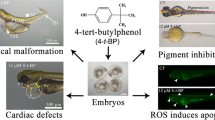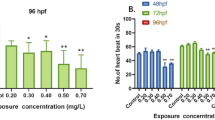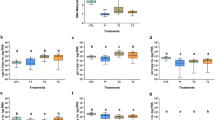Abstract
Alkylated polycyclic aromatic hydrocarbons (alkyl-PAHs) are the predominant form of PAHs in crude oils, of which, 3–5 ring alkyl-PAH may cause dioxin-like toxicity to early life stages of fish. Retene (7-isopropyl-1-methylphenanthrene), a typical alkyl-phenanthrene compound, can be more toxic than phenanthrene, and the mechanism of retene toxicity is likely related to its rapid biotransformation by cytochrome P450 (CYP) enzymes to metabolites with a wide array of structures and potential toxicities. Here, we investigated how α-naphthoflavone (ANF), a cytochrome P450 1A (CYP1A) inhibitor, affected the embryotoxicity of retene and the role that CYP1A inhibition may play in the interactions. Marine medaka (Oryzias melastigma) embryos were exposed, separately or together, to 200 μg/L retene with 0, 5, 10, 100, and 200 μg/L ANF for 14 days. The results showed that ANF significantly inhibited the induction of CYP1A activity by retene; however, ANF interacted with retene to induce significant developmental toxicity and genotoxicity at 10, 100, and 200 μg/L (p < 0.01). Tissue concentrations of retene and its metabolites and lipid hydroperoxide (LPO) activity also increased, whereas the inhibition of the glutathione S-transferase (GST) activity and the alteration in metabolic profiles of retene were observed. The interactions of retene with ANF indicate that CYP1A inhibition was possibly act through different mechanisms to produce similar developmental effects and genotoxicity. Retene metabolites and altered metabolic profile were likely responsible for retene embryotoxicity to marine medaka. Therefore, elevated toxicity of alkyl-phenanthrene under CYP1A inhibitor suggested that the ecotoxicity of PAHs in coastal water may have underestimated the threat of PAHs to fish or ecosystem.





Similar content being viewed by others
References
Banoglu E (2000) Current status of the cytosolic sulfotransferases in the metabolic activation of promutagens and procarcinogens. Curr Drug Metab 1(1):1–30
Barron MG, Heintz R et al (2004) Relative potency of PAHs and heterocycles as aryl hydrocarbon receptor agonists in fish. Mar Environ Res 58(2-5):95–100
Bauder MB, Palace VP et al (2005) Is oxidative stress the mechanism of blue sac disease in retene-exposed trout larvae? Environ Toxicol Chem 24(3):694–702
Billiard SM, Querbach K et al (1999) Toxicity of retene to early life stages of two freshwater fish species. Environ Toxicol Chem 18(9):2070–2077
Billiard SM, Hahn ME et al (2002) Binding of polycyclic aromatic hydrocarbons (PAHs) to teleost aryl hydrocarbon receptors (AHRs). Comp Biochem Physiol B Biochem Mol Biol 133(1):55–68
Billiard SM, Bols NC et al (2004) In vitro and in vivo comparisons of fish-specific CYP1A induction relative potency factors for selected polycyclic aromatic hydrocarbons. Ecotoxicol Environ Saf 59(3):292–299
Billiard SM, Timme-Laragy AR et al (2006) The role of the aryl hydrocarbon receptor pathway in mediating synergistic developmental toxicity of polycyclic aromatic hydrocarbons to zebrafish. Toxicol Sci 92(2):526–536
Billiard SM, Meyer JN et al (2008) Nonadditive effects of PAHs on early vertebrate development: mechanisms and implications for risk assessment. Toxicol Sci 105(1):5–23
Blackburn AC, Matthaei KI et al (2006) Deficiency of glutathione transferase zeta causes oxidative stress and activation of antioxidant response pathways. Mol Pharmacol 69(2):650–657
Bo J, Cai L et al (2011) The marine medaka Oryzias melastigma—a potential marine fish model for innate immune study. Mar Pollut Bull 63(5-12):267–76
Bolton JL, Trush MA et al (2000) Role of quinones in toxicology. Chem Res Toxicol 13(3):135–160
Brown DR, Bailey JM et al (2016) Developmental exposure to a complex PAH mixture causes persistent behavioral effects in naive Fundulus heteroclitus (killifish) but not in a population of PAH adapted killifish. Neurotoxicol Teratol 53(1):55–63
Carls MG, Rice SD et al (1999) Sensitivity of fish embryos to weathered crude oil: Part I. Low-level exposure during incubation causes malformations, genetic damage, and mortality in larval pacific herring (Clupea pallasi). Environ Toxicol Chem 18(3):481–493
Chang TK, Gonzalez FJ et al (1994) Evaluation of triacetyloleandomycin, alpha-naphthoflavone and diethyldithiocarbamate as selective chemical probes for inhibition of human cytochromes P450. Arch Biochem Biophys 311(2):437–442
Clark BW, Cooper EM et al (2013) Compound- and mixture-specific differences in resistance to polycyclic aromatic hydrocarbons and PCB-126 among Fundulus heteroclitus subpopulations throughout the Elizabeth River estuary (Virginia, USA). Environ Sci Technol 47(18):10556–10566
Fang M, Getzinger GJ et al (2014) Effect-directed analysis of Elizabeth River porewater: developmental toxicity in zebrafish (Danio rerio). Environ Toxicol Chem 33(12):2767–2774
Fragoso NM, Hodson PV et al (2006) Evaluation of an exposure assay to measure uptake of sediment PAH by fish. Environ Monit Assess 116(1-3):481–511
Garner LVT, Giulio DRT (2012) Glutathione transferase pi class 2 (GSTp2) protects against the cardiac deformities caused by exposure to PAHs but not PCB-126 in zebrafish embryos. Comp Biochem Physiol C Toxicol Pharmacol 155(4):573–579
Hawkins SA, Billiard SM et al (2002) Altering cytochrome P4501A activity affects polycyclic aromatic hydrocarbon metabolism and toxicity in rainbow trout (Oncorhynchus mykiss). Environ Toxicol Chem 21(9):1845–1853
Hodson PV, Qureshi K et al (2007) Inhibition of CYP1A enzymes by α-naphthoflavone causes both synergism and antagonism of retene toxicity to rainbow trout (Oncorhynchus mykiss). Aquat Toxicol 81(3):275–285
Incardona JP, Carls MG et al (2008) Cardiac arrhythmia is the primary response of embryonic Pacific herring (Clupea pallasi) exposed to crude oil during weathering. Environ Sci Technol 43(1):201–207
Iwamatsu T (2004) Stages of normal development in the medaka Oryzias latipes. Mech Dev 121(7-8):605–618
Jayasundara N, Van Tiem GL et al (2015) AHR2-mediated transcriptomic responses underlying the synergistic cardiac developmental toxicity of PAHs. Toxicol Sci 143(2):469–481
Kiparissis Y, Balch GC et al (2003) Effects of the isoflavones genistein and equol on the gonadal development of Japanese medaka Oryzias latipes. Environ Health Perspect 111(9):1158–1163
Knecht AL, Goodale BC et al (2013) Comparative developmental toxicity of environmentally relevant oxygenated PAHs. Toxicol Appl Pharmacol 271(2):266–275
Leppänen H, Oikari A (1999) Occurrence of retene and resin acids in sediments and fish bile from a lake receiving pulp and paper mill effluents. Environ Toxicol Chem 18(7):1498–1505
Lin H, Morandi GD et al (2015) Quantitative structure activity relationships for chronic toxicity of alkyl-chrysenes and alkyl-benz[a]anthracenes to Japanese medaka embryos (Oryzias latipes). Aquat Toxicol 159(1):109–118
Malmquist LM, Selck H et al (2015) Polycyclic aromatic acids are primary metabolites of alkyl-PAHs—a case study with Nereis diversicolor. Environ Sci Technol 49(9):5713–5721
Miranda CL, Henderson MC et al (1998) Evaluation of chemicals as inhibitors of trout cytochrome P450s. Toxicol Appl Pharmacol 148(2):237–244
Mu JL, Wang JY et al (2014) Comparative embryotoxicity of phenanthrene and alkyl-phenanthrene to marine medaka (Oryzias melastigma). Mar Pollut Bull 85(2):505–515
Nacci D, Coiro L et al (1998) Nondestructive indicator of ethoxyresorufin-O-deethylase activity in embryonic fish. Environl Toxicol Chem 17(12):2481–2486
Rowe CL, Mitchelmore CL et al (2009) Lack of biological effects of water accommodated fractions of chemically- and physically-dispersed oil on molecular, physiological, and behavioral traits of juvenile snapping turtles following embryonic exposure. Sci Total Environ 407(20):5344–55
Schlezinger JJ, Struntz WD et al (2006) Uncoupling of cytochrome P450 1A and stimulation of reactive oxygen species production by co-planar polychlorinated biphenyl congeners. Aquat Toxicol 77(4):422–432
Scott J (2009) The mechanism of retene toxicity in the early life stages of fish. Ph.D thesis, Queen’s University, Kingston, Ontario, Canada 80–85
Scott JA, Hodson PV (2008) Evidence for multiple mechanisms of toxicity in larval rainbow trout (Oncorhynchus mykiss) co-treated with retene and alpha-naphthoflavone. Aquat Toxicol 88(3):200–206
Scott JA, Incardona JP et al (2011) AhR2-mediated, CYP1A-independent cardiovascular toxicity in zebrafish (Danio rerio) embryos exposed to retene. Aquat Toxicol 101(1):165–174
Sette CB, Pedrete TA et al (2013) Formation and identification of PAHs metabolites in marine organisms. Mar Environ Res 91:2–13
Takahashi N, Miranda CL et al (1995) Inhibition of in vitro aflatoxin B 1-DNA binding in rainbow trout by CYP1A inhibitors: α-naphthoflavone, β-naphthoflavone and trout CYP1A1 peptide antibody. Comp Biochem Physiol C Pharmacol Toxicol Endocrinol 110(3):273–280
Tavendale MH, McFarlane PN et al (1997) The fate of resin acids-1. The biotransformation and degradation of deuterium labelled dehydroabietic acid in anaerobic sediments. Chemosphere 35(10):2137–2151
Thewes M, Elsner E et al (2000) The urokinase plasminogen activator system in angiosarcoma, Kaposi’s sarcoma, granuloma pyogenicum, and angioma: an immunohistochemical study. Int J Dermatol 39(3):188–191
Timme-Laragy AR, Van Tiem LA et al (2009) Antioxidant responses and NRF2 in synergistic developmental toxicity of PAHs in zebrafish. Toxicol Sci 109(2):217–227
Turcotte D, Headley JV et al (2011) Identification of phase II in vivo metabolites of alkyl-anthracenes in rainbow trout (Oncorhynchus mykiss). Chemosphere 85(10):1585–1591
Wassenberg DM, Di Giulio RT (2004) Synergistic embryotoxicity of polycyclic aromatic hydrocarbon aryl hydrocarbon receptor agonists with cytochrome P4501A inhibitors in Fundulus heteroclitus. Environ Health Perspect 112(17):1658–1664
Wassenberg DM, Nerlinger AL (2005) Effects of the polycyclic aromatic hydrocarbon heterocycles, carbazole and dibenzothiophene, on in vivo and in vitro cypia activity and polycyclic aromatic hydrocarbon-derived embryo deformities. Environ Toxicol Chem 24(10):2526–2532
Willett KL, Wassenberg D et al (2001) In vivo and in vitro inhibition of CYP1A-dependent activity in Fundulus heteroclitus by the polynuclear aromatic hydrocarbon fluoranthene. Toxicol Appl Pharmacol 177(3):264–71
Wills LP, Zhu S et al (2009) Effect of CYP1A inhibition on the biotransformation of benzo[a]pyrene in two populations of Fundulus heteroclitus with different exposure histories. Aquat Toxicol 92(3):195–201
Acknowledgments
This research was supported by the National Natural Science Foundation of China (Nos. 41476096 and 41106089), the Scientific Research Special Fund of Marine Public Welfare Industry (Nos. 201305002 and 201205012), and the Project on Chronic toxicity of Spill Oil to marine organisms, State Oceanic Administration (SDFZQ20141124-036-3). We also thank Dr. R.J. Sun from the National Marine Environmental Monitoring Center for her kind help during manuscript revision.
Author information
Authors and Affiliations
Corresponding author
Additional information
Responsible editor: Thomas Braunbeck
Electronic supplementary material
Below is the link to the electronic supplementary material.
ESM 1
(XLSX 35 kb)
Rights and permissions
About this article
Cite this article
Mu, J., Jin, F., Wang, J. et al. The effects of CYP1A inhibition on alkyl-phenanthrene metabolism and embryotoxicity in marine medaka (Oryzias melastigma). Environ Sci Pollut Res 23, 11289–11297 (2016). https://doi.org/10.1007/s11356-016-6098-2
Received:
Accepted:
Published:
Issue Date:
DOI: https://doi.org/10.1007/s11356-016-6098-2




